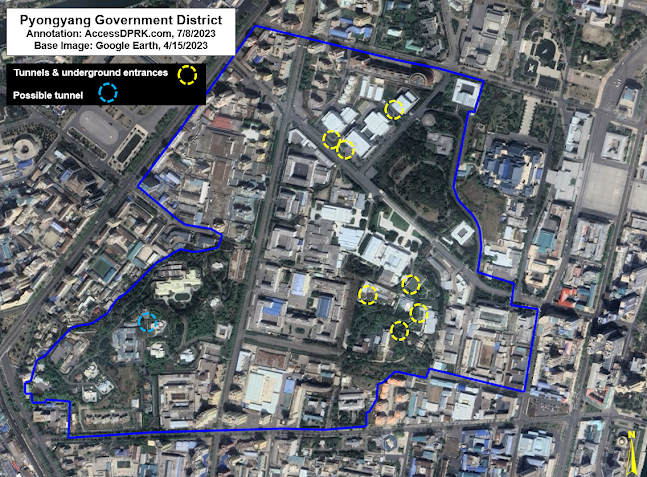Verifying the existence of underground facilities can be a difficult task, especially when their existence is a state secret. But rumors eventually come out and tantalizing hints of their presence can sometimes be found.
For North Korea, these rumors tell of secret subway lines beneath Pyongyang and underground highways connecting major palaces, maybe even reaching as far north as the border with China. I have written quite a lot about North Korea's underground infrastructure, but direct evidence and declassified sources still remain scarce.
However, within the secured government district of Pyongyang are signs of multiple tunnels and underground structures. While it's impossible to know how they all connect to one another or even if they do, their locations and prevalence do hint at a fairly robust underground network that supports the infrastructure, transportation, and security needs of Pyongyang's most important district.
The easiest way to identify underground facilities is to either spot their entrances or actually catch them being constructed. For the secured government district, most of the buildings were constructed decades ago, placing their secrets out of reach for those without security clearances. But under Kim Jong Un, there have been some substantial changes to the district and that has given North Korea watchers an opportunity to see observe some of them.
There are two main sets of tunnels within the 138-hectare district that are visible to satellite. The first is a set of four tunnels near the Central Committee Office building (also known as Kim Jong Un's office) and the adjacent villa (Residence No. 15). The second is a set of four tunnels leading to underground parking garages beneath three buildings that were constructed in 2018-2019.
There is also a possible tunnel, marked in light blue, but I can't fully verify that it is a tunnel. In some images, however, it appears that there may be a road tunnel that dives under a gate near Kim Kyong-hui Hall, just south of Changgwangsan House.
But the tunnels around Kim Jong Un's office and Residence No. 15 are quite clear.
To the north of the Central Committee Office Building, between 2018 and 2020 four currently unidentified buildings were constructed. These buildings include glass-covered entrances to underground parking garages that, most likely, would also double as bomb shelters in the event of an air attack.
There are also reports (including from Hwang Jang-yop) that the Pyongyang Metro has a secret line for government use that connects important government and military installations around the capital, and that it even reaches as far as Nampo and Sunchon (50 km away). While this has never been independently verified, the government district does lie within 2 km of four subway stations, with the closest being Pongwa Station at only 600 meters away from Kim's office.
As most of the district was constructed in the 1960s and 1970s (as was the metro), underground entrances to the metro system could be hidden beneath key administrative buildings, beyond the prying eye of today's satellite fleet. I have doubts about a sprawling network of transportation tunnels connecting far flung facilities, but a local network connecting underground command centers and emergency escape routes is quite plausible.
Whether underground sites exist in isolation or connect to larger tunnel networks beneath the government district and beyond, the sheer number of bomb shelters and other underground facilities alleged to exist makes the possibility of a successful "decapitation strike" by South Korea or the United States far more difficult and less likely to be effective, as such an attack relies on knowing where the target individuals are and killing them before they have time to escape to another location.
While I can't comment as to the quality of their construction, as a regime hyper-focused on survivability, North Korea probably has the greatest density of underground facilities and secret tunnels of any country on earth.
I would like to thank my current Patreon supporters who help make all of this possible: Alex Kleinman, Amanda Oh, Donald Pierce, Dylan D, Joe Bishop-Henchman, Jonathan J, Joel Parish, John Pike, JuneBug, Kbechs87, Nate Odenkirk, Russ Johnson, and Squadfan.









No comments:
Post a Comment